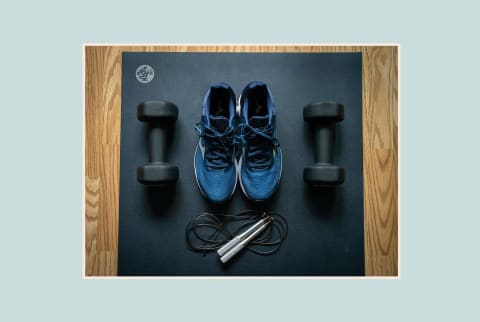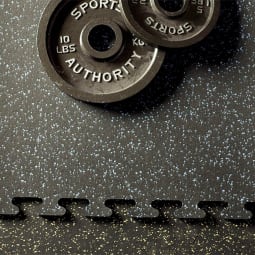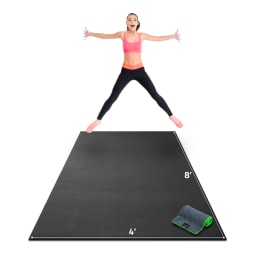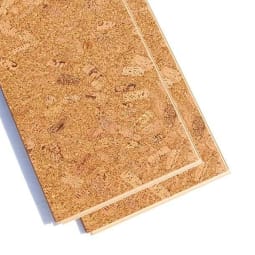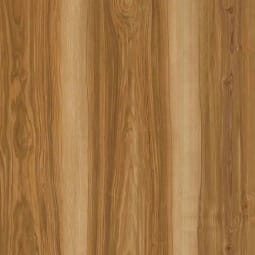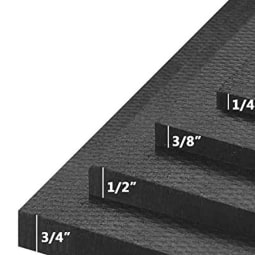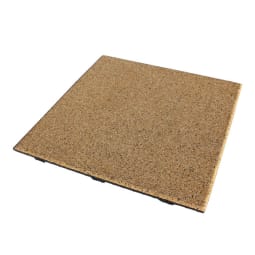Who wants to stress about dinging that hardwood with your new kettlebell, hammering your joints on unforgiving tile, or smushing your carpet with your gigantic treadmill when you’re trying to get your sweat on? That’s where dedicated home gym flooring comes in. We worked alongside fitness and interior design experts to round up seven of the best options for specific workouts, so you’ll have the foundation you need (literally) for some serious training. “Proper flooring takes proper care of your body,” explains Paul Fischer, a certified personal trainer and owner of Framework Personal Training. A supportive, grippy surface will offer shock absorption and cushion your joints while also minimizing the risk of slipping and falling, no matter how sweaty you get. Dropping a little money on a dedicated gym floor also protects your home, says Felicia Rish, senior commercial interior designer at Architects in Partnership. “If you drop a 20-pound kettlebell on hard surfaced flooring, you’ll probably have a new ding in your wood flooring or a chunk missing from your concrete floor,” Rish explains. There’s also a psychological component to a good gym floor. “Your environment contributes to your success,” says Fischer. “A room that is set up for intentional exercise is another tool for goal setting. Just like studying in a quiet room, a proper gym creates positive habits.” If you’re side-eyeing your carpet right this minute, keep in mind that many types of flooring can support a solid workout. “It’s perfectly safe to work out on existing home surfaces like laminate and carpet, though these can provide less grip than traditional rubber flooring,” explains Kerri Husk, sports therapist and owner of Huskie Sports Therapy & Performance. But if your current floor has no give (think tile and polished or bare concrete), certain workouts will require the addition of a good fitness mat at the very least. They’ll absorb impact to protect your floors, and the seamless interlocking design means there’s no adhesive is necessary. The tiles simply fit together like giant puzzle pieces. That’s a benefit, as Fischer points out that rubber flooring has a tendency to shift and shrink. “I like the interlocking rubber tiles, as they keep tight seams,” he says. The tile approach also keeps things flexible. “In a home situation, I would opt for a floating rubber system rather than a rolled system,” recommends Rish. “That’s mainly because most rolled systems require an adhesive.” If you need the option of converting that home gym into a nursery in a few years, these interlocking tiles will be easy to take apart with no damage to your floor. At one-quarter inch thick, these mats offer the absorption you want during high-impact workouts. And since they roll right up when you’re done, they quite literally turn any room in your home into a usable gym space. Another bonus: unlike most other flooring materials, cork is a renewable resource that won’t shed microfibers or trap dust. Plus, it’s super easy to keep clean (though it isn’t completely water-resistant). This option from Lifeproof is antimicrobial to resist mold and mildew. It’s also scratch and stain resistant and waterproof if you’re feeling the Bikram yoga. While you will have to install it, the drop-and-lock system is straightforward. Plus, it can go right over existing tile, wood, concrete, and vinyl floors. Laminate, hardwood, and even polished concrete also tend to crop up in the yoga world, but Rish still prefers vinyl for its slip resistance, she says. “I would go with something that does not have a beveled edge,” Rish adds. “Dirt likes to make a home in the crevices so save yourself some sanity and make sure it has a flat edge.” These stand-alone mats are heavy enough to stay put no matter how nasty that left hook/right round gets, and a proprietary manufacturing process ensures they’ll always lay flat—no curling edges here. They come in multiple sizes and thicknesses, and there are even options for a little splash of color. The tiles have a patented wear layer for long-term durability and come with a 15-year warranty.



